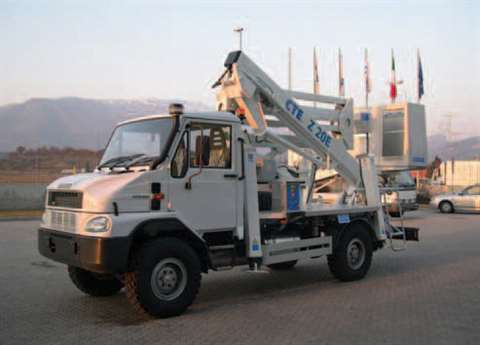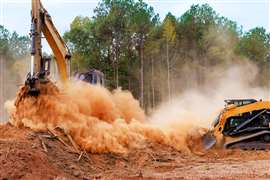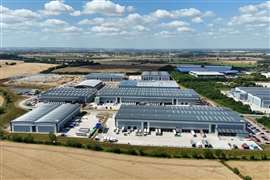The right truck?
24 April 2008

Vehicle mounted access platforms are considered by many to be a very specialist product for niche markets. In fact, many tasks can be more efficiently carried out by such machines than with a self propelled boom. For rental companies, truck mounts can provide some very worthwhile profit opportunities, and for end-users they hold the promise of improved productivity. But these benefits will only be realised if you specify the appropriate combination of platform and vehicle.
Choosing a vehicle mounted platform is not dissimilar to specifying a self propelled machine, with one major difference - the purchaser can determine the chassis characteristics best suited to the target application’s specific needs. As obvious as this seems, it is surprising how often companies make a high value investment but simply accept whichever vehicle the platform manufacturer decides to supply. By understanding the suitability of various chassis characteristics to the application, the most cost-effective combination of platform and vehicle can be determined.
Key considerations in the choice of vehicle include:
1. Terrain
The big advantage of vehicle mounted platforms is their ability to deliver themselves to the work location. For many applications this may not be limited to metalled road surfaces; overhead line work, communication masts, wind farms and even outside broadcast duties may all entail leaving the road and traversing rough terrain. The correct number of driven wheels, chassis ground clearance and an appropriate wheelbase to ensure good approach and departure angles are all important considerations.
2. Work Locations
Apart from ground conditions, physical size of the vehicle is an important consideration. Obviously in confined urban locations a compact vehicle with short overall length and a good turning circle will be a benefit in city streets. There is always a trade-off, however, when choosing small light vehicles - the space required to actually operate the machine. Greater outrigger widths are often required for stability on lighter vehicles, so although the vehicle may be capable of driving into a narrow alleyway, it may not be able to actually operate in this position.
3. Driver and operator licensing
By ‘operator’ we are referring here to the organisation that runs the vehicle, not the person operating the platform. Consideration must be given to both the qualifications of the individual who has to drive the vehicle on the road and to the statutory obligations demanded by state bodies responsible for enforcement of road regulations. A rental company may restrict their available market if a Heavy Goods Vehicle (HGV) licence is required for their self drive vehicles. Fortunately there are many platforms on the market now which reach up to 20 m working height yet can be driven on a normal car drivers licence.
For platforms over 26 metres special IPAF operators training is required so it makes sense for rental companies to provide these units complete with an operator/delivery driver, providing an increased profit opportunity by offering an enhanced service.
The issue of a Heavy Goods Operators Licence(the so called ‘O’-Licence in the UK) can be onerous for owner-operators and small contractors without experience of these vehicles. In this case it makes sense to avoid vehicles of over 3.5 tonnes GVW so that issues such as regular three monthly inspections and tachograph regulations do not arise. Fleet operators already used to running larger vehicles need not be concerned about such considerations and are free to choose a vehicle that best suits the platform’s specific characteristics and provides adequate payload.
4. Payload and storage
This is an important issue which can easily be overlooked. Payload is the spare carrying capacity available with the vehicle in normal operating condition (i.e. the difference between Gross Vehicle Weight (GVW) / Maximum Vehicle Mass (MVM) and the total of Kerb Weight PLUS crew weight PLUS fuel weight). Whether this is significant depends on the application of the platform. Rental companies will generally not worry about ensuring significant spare payload for tools and materials as in these situations it is used just like a self propelled or trailer - to get an operator to the height required, do the job and return to base. However for contractors it is a real bonus if the platform not only delivers itself to site, but can also deliver all of the personnel, tools, equipment and plant necessary for the task. Road regulations will not permit any vehicle to be driven on the road if its weight exceeds the plated GVW/MVM. Enforcement varies but this issue is heavily policed in some countries and will lead to fines and licence endorsements for both drivers and owners if ignored.
Other important considerations are the physical space and storage facilities on board the vehicle. Security and weatherproofing are important for delicate electrical components, valuable tools and other equipment such as CCTV cameras, generators etc. On chassis cab vehicles, purpose built lockers accessible from either road level or the rear deck are important features to be considered. In some cases full height workshop bodies are fitted under the boom to provide not only storage but welfare and weatherproof working facilities. Because this can add considerable cost and extra weight, van mounted platforms are becoming increasingly popular for applications up to 18 m. The van body is an integral structural element of the vehicle so it does not add much to the kerb weight but offers fully accessible, secure storage at little extra cost. A wide selection of vans from 3.5 to 7.5 tonnes GVW are now available from various manufacturers.
5. Vehicle manufacturer
Build quality, reliability, dealer network and pricing all need to be considered when selecting the carrier vehicle. All access platforms, but especially taller machines, are relatively expensive compared to the vehicle. Given that the platform is likely to remain in service for up to 10 years, a few euros or dollars saved at the outset can represent a poor investment later on. It is vital to consider whole life costs including depreciation and residual value - remounting onto a new vehicle is a very expensive operation.
Platform Characteristics
Once the most suitable vehicle type is selected the more familiar platform features can be determined. These include;
•maximum working height and outreach
•boom type
•platform capacity
•outrigger considerations
•optional equipment
Some issues to consider are:
1. Maximum working height
It is often impossible to get a vehicle mounted platform directly under the work location, so the stated maximum height is rarely useable. Typically the vehicle is parked on the road adjacent to the job, so it is vital to make sure that the required height is achievable at the necessary horizontal distance. For platforms on lighter vehicles, do not forget to allow for the outrigger spread.
2. Outreach
Most modern telescopic machines achieve tall working heights on light vehicles by limiting outreach at maximum load. Most manufacturers quote ‘headline’ outreach figures with just 80 or 100 kg load in the platform. If you know that more than a single operator will be in the cage, make sure sufficient outreach is available at the load required.
3. Boom type
The usual considerations of whether to choose a telescopic boom for simplicity of operation and maximum height, or articulated for up-and-over ability, apply in the same way as for a self propelled machine. However, bearing in mind many vehicle mounts are used at roadside locations, you must consider whether the knuckle projection of an articulated boom is permissible. This may well extend into traffic at lower working heights and will require the operator to be alert to this risk at all times. Many councils and contractors will not rent knuckle booms for street lighting applications.
As with self propelled booms, jibs are a valuable addition for increased versatility. They also provide on a vehicle mount the opportunity to fit the platform to a van or chassis cab with a box body, and/or to allow access to the working cage from ground level if required.
4. Platform type and capacity
Most smaller vehicle mounts are limited to a maximum of two operators (typically 200 kg SWL). Over 25 m, higher SWL and larger platforms for up to 3, 4 or even more occupants are available, normally as an option. Most van and truck mounts used for street lighting and electrical work (up to about 18 m) are fitted with fibreglass or other types of plastic basket. Tubular aluminium or steel platforms are preferred for maintenance work as they offer easier access to the job.
5. Outriggers
Outriggers are a feature of vehicle mounted platforms which can cause operational problems if not carefully considered beforehand. There is no magic formula - if large outreach is required on a light vehicle, outrigger spread will be significant. When specifying, make sure you are aware of the options and select the most suitable:
a. Vertical: The best option for roadside work, stabilisers stay within the vehicle body width. These are usually only available on relatively heavy vehicles.
b. A-type: Widely used on vans and light chassis cabs, including off-road vehicles, the spread can be quite limited and if the stabiliser feet remain within the mirror width of the vehicle may be no problem. The outriggers will extend the same distance both sides so can take up a large amount of space in roadside applications.
c. Flap-down: Often used on tall 3.5t chassis cab installations, usually for the front pair of outriggers, these extend both sideways and forward and are intrusive on roadside applications.
d. H-type and variable: Used primarily on larger truck mounts, these can be very wide and would normally preclude roadside use without traffic restrictions. However, many machines are offered with variable jacking letting the user select between vertical jacking within the vehicle width, full width jacking on closed roads/construction sites or extended one side only (nearside). In these cases, the platform’s outreach is controlled accordingly to maintain stability. More advanced machines have fully-variable jacking so each outrigger can be positioned anywhere space constraints or site obstructions allow, and the shape of the working envelope is adjusted constantly by the control system’s computer.
6. Optional equipment
To a far greater extent than on self-propelled machines, vehicle mounted platforms are offered with a wide variety of optional equipment allowing them to be tailored to specific applications. Typical items include various warning beacons, lockers and bodywork, handwash units, electrical generators and air compressors, various working platform styles and sizes including quick change options and service lines inside the boom for electricity, compressed air or water supplies at the platform. Some carefully selected options on rental machines can provide a real benefit to certain types of user and provide differentiation from competitors.




